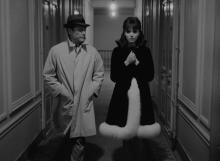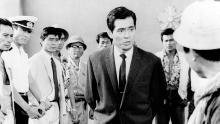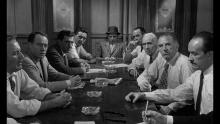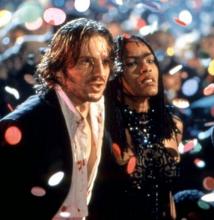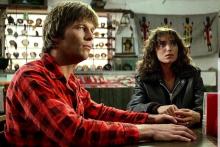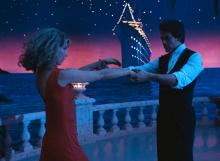The following notes on The Pianist were written by Nick Sansone, PhD Student in the Department of Communication Arts at UW-Madison. A new 4K DCP of The Pianist will screen on Friday, April 19 at 7 p.m. The screening takes place in our regular venue, 4070 Vilas Hall, 821 University Avenue. Admission is Free.
By Nick Sansone
Roman Polanski’s The Pianist begins on a somber, even disorienting note. Instead of studio logos or opening credits, we open on archival footage of Warsaw, Poland in 1939, just before the Nazi invasion. The footage runs silently, accompanied by a lone piano playing Chopin’s “Nocturne in C-sharp Minor”, which we then see is being played by the nimble hands of Władysław Szpilman (Adrien Brody), our titular pianist, as part of a live radio performance. As the camera settles on Szpilman, the sound of an explosion is heard off-screen, and the serenity of the music from his hands cannot hide the consternation on his face. Then, another explosion, this one louder and obviously closer. Szpilman is rattled but his music continues. One more explosion, this one close enough to shatter a window in the recording booth. And yet, Szpilman’s performance continues—gently, beautifully, and defiantly unwavering even as rubble falls around him.
This opening scene represents Szpilman’s journey to come in microcosm, a story of an indomitable will to survive and of art ennobling one man’s (and mankind’s) spirit amidst its darkest days. Szpilman’s harrowing story of survival was published as a memoir titled The Pianist in 1946, one year after the end of the war, earning him the reputation as the most well-known of the so-called “Robinson Crusoes of Warsaw,” a title given to those who hid in the city’s ruins after the 1944 Uprising. After Szpilman’s death in 2000, the memoir attracted the attention of another Jewish survivor of Nazi-occupied Poland, film director Roman Polanski, an artist whose life had been marked by tragedy and controversy in equal measure.
Polanski was just six years old when the Nazis invaded his native Poland in 1939. After the invasion, he and his family were forced into the Kraków ghetto, where they spent a little over three years before its liquidation in 1943. Although Polanski was able to escape capture by the Nazis, his parents and his sister were detained and sent to concentration camps. While his father and sister managed to survive, his pregnant mother was killed in a gas chamber soon after arriving at Auschwitz. Surviving on his own as a child, Polanski found safe harbor with a series of different families, hiding his Jewish heritage and enduring the cruelty of the occupying Nazi army. Although he was able to reunite with his father following the Germans’ surrender, their relationship was forever strained by their shared trauma, and he began to take solace in the cinema, the art form that would finally give him meaning and purpose in his young life.
It would be almost six decades before Polanski would explicitly deal with this formative period of his life. In those sixty years, Polanski became a breakout international filmmaker before moving to Hollywood to direct such classics as Rosemary’s Baby and Chinatown, films as beautiful as they are pitiless about the darkest depths of humanity. Polanski’s career as a Hollywood director ended abruptly, however, when he was arrested for drugging and raping 13-year-old Samantha Gailey. Despite accepting a plea bargain that would have dropped the most punitive of the charges, Polanski fled to Europe, settling in France, where he remains to this day.
While a fugitive in France, Polanski remained an active filmmaker, though his output was met with a much more mixed reception, not to mention an air of controversy. About ten years prior to The Pianist, he turned down an offer from Steven Spielberg to direct Schindler’s List, in part due to a fear that he could not be objective in his depiction (one of its main sequences depicts the very liquidation of the Warsaw ghetto that Polanski himself survived). Nevertheless, in the year 2000 Polanski announced his adaptation of Szpilman’s memoir. When explaining what drew him to adapt Szpilman’s memoir, besides the obvious personal connections to his own life, Polanski said he appreciated that the book “breaks a lot of stereotypes, and is told without a desire for revenge,” and that, “though the subject matter is bleak, it’s treated objectively, which is what I like […] Szpilman’s book makes a very strong impression through the details. It has that peculiar brand of precision and distance that the survivor often carries with him.”
The Pianist premiered at the Cannes Film Festival in May 2002 and was immediately embraced as a major artistic comeback for Polanski, winning the Palme d’Or and becoming Polanski’s most acclaimed movie in nearly two decades. The film went on to a healthy box-office run in America and was awarded three Oscars at that year’s Academy Awards, including Best Actor for Adrien Brody (at 29, still the youngest winner of the award) and, controversially, Best Director for Polanski. Polanski, still a fugitive from justice, was not able to attend the ceremony, yet received a standing ovation from the crowd at the Kodak theater. It would be another fifteen years before Hollywood began seriously reckoning with its long history of minimizing sexual exploitation and its vocal support of Polanski (and many men like him). In the wake of the Me Too movement, Polanski has continued working, premiering his most recent film, The Palace, at Cannes in 2023, but he has finally been deemed persona non grata in Hollywood, and his most recent films have not found distribution in the States.
The controversy surrounding Polanski unfortunately colors the perception of all his work; it is impossible to fully separate the artist from the art, as masterful as that art may be. And make no mistake, The Pianist, like so many of Polanski’s films, is the work of a great artist. Even today, it stands as a towering depiction of both unspeakable inhumanity of the Holocaust and the indefatigable spirit of those who were able to survive, featuring some of the most profoundly impactful and technically impressive work of Polanski’s entire career. It’s also among Polanski’s most personal works, one survivor telling the story of another, two men bonded by a shared tragedy and a shared belief in the power of art to stir the human spirit. For a man who has been a victim, a perpetrator, and an artist exploring man’s inhumanity, The Pianist stands out as an uncommonly graceful, soulful story of survival, albeit one that is both elevated and marred by its own creator.


